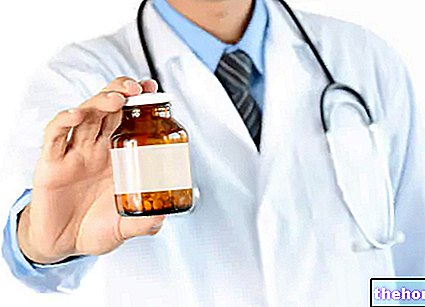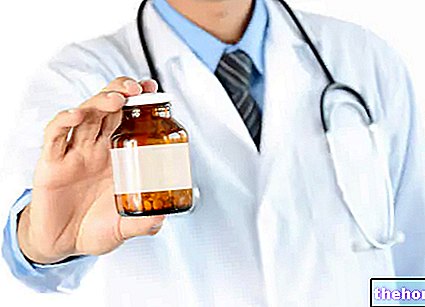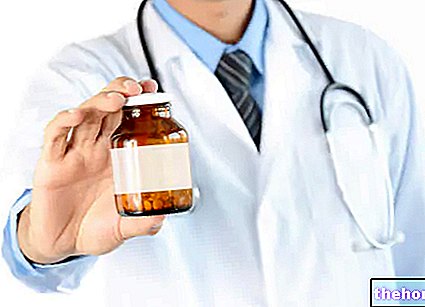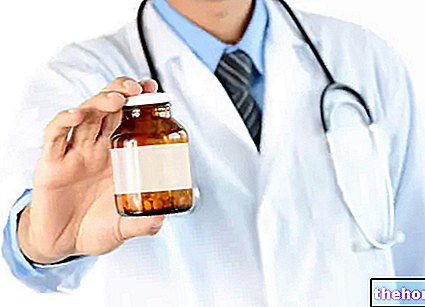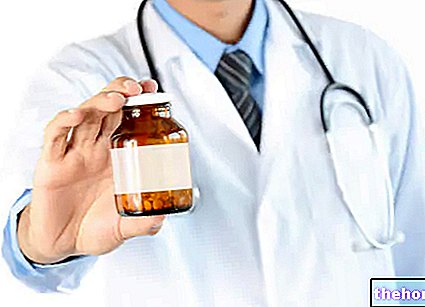Active ingredients: Dextromethorphan (dextromethorphan hydrobromide)
BISOLVON COUGH SEDATIVE 2 mg / ml syrup
The package inserts of Bisolvon Cough Sedative are available for pack sizes:- BISOLVON COUGH SEDATIVE 2 mg / ml syrup
- BISOLVON COUGH SEDATIVE 10.5 mg gummy tablets
Why is Bisolvon Cough Sedative used? What is it for?
WHAT IS IT
Bisolvon cough sedative is a cough suppressant (calms the cough).
WHY IT IS USED
Bisolvon cough sedative is used as a cough suppressant.
Contraindications When Bisolvon Cough Sedative should not be used
Hypersensitivity to the active substance or to any of the excipients.
Do not use at the same time or in the two weeks following MAO inhibitor antidepressant drugs (see "What medicines or foods can change the 'effect of the medicine').
Bronchial asthma, COPD (chronic obstructive pulmonary disease), pneumonia, breathing difficulties, respiratory depression, cardiovascular disease, hypertension, hyperthyroidism, glaucoma, prostatic hypertrophy, stenosis of the gastrointestinal and urogenital tract, epilepsy, severe liver disease. less than 12 years old and to patients with fructose intolerance.
Pregnancy and lactation (see: What to do during pregnancy and lactation) and in case of rare hereditary conditions of incompatibility with one of the excipients (see: It is important to know that).
It should not be used at the same time as drinking alcohol.
When it can be used only after consulting your doctor
Subjects with impaired hepatic and renal function (see "Precautions for use").
If you have a productive cough with a large amount of mucus (phlegm) (see "Precautions for use").
In patients taking certain classes of drugs (see "Precautions for use").
In cases where these disorders have also occurred in the past, it is advisable to consult a doctor.
Dextromethorphan may be mildly addictive following prolonged use (e.g. exceeding the recommended treatment period), patients may develop tolerance to the drug, as well as mental and physical dependence. Patients with a tendency to abuse or dependence should take bisolvon cough sedative for short periods and under close medical supervision.
Cases of dextromethorphan abuse have been reported, predominantly in adolescents.
Precautions for use What you need to know before taking Bisolvon Cough Sedative
Bisolvon sedative cough should be used with caution in patients taking serotonergic drugs (other than MAO inhibitor drugs), such as selective serotonin reuptake inhibitors (SSRIs) (e.g. fluoxetine, paroxetine) or tricyclic antidepressant drugs (see section "Which ones medicines or foods can change the 'effect of the medicine').
There is limited information on the use of dextromethorphan in patients with impaired hepatic or renal function. Therefore, sedative bisolvon cough should be administered with caution in such patients, especially in patients with severe impairment.
Due to the potential for histamine release, the use of sedative bisolvon cough should be avoided in case of mastocytosis.
Bisolvon sedative cough is not indicated, particularly in children, for the suppression of chronic cough, as a possible early symptom of asthma.
In the case of a productive cough, with a significant production of mucus (phlegm) (e.g. in patients with diseases such as bronchiectasis and cystic fibrosis) or in patients with neurological diseases associated with a marked reduction in the cough reflex (such as stroke , Parkinson's disease and dementia), treatment of Bisolvon cough sedative as a cough suppressant should be administered with particular caution and only on medical advice, after a "careful risk-benefit assessment (see section" Which medicines or foods can modify the "effect of the medicinal product").
It is not advisable to drink alcohol during therapy (see "What medicines or foods can change the" effect of the medicine ").
Bisolvon sedative cough should not be used in children under 12 years of age.
If after 5-7 days of treatment no appreciable results are obtained, consult your doctor.
Prolonged treatment beyond 5-7 days is not recommended.
Interactions Which drugs or foods can modify the effect of Bisolvon Cough Sedative
Tell your doctor or pharmacist if you have recently taken any other medicines, even those without a prescription.
Dextromethorphan possesses weak serotonergic properties. Dextromethorphan may therefore lead to an increased risk of serotonergic toxicity (serotonin syndrome), especially when taken in conjunction with other serotonergic agents, such as MAO inhibitors or SSRIs or tricyclic antidepressants.Especially pre-treatment or concomitant treatment with drugs that impair serotonin metabolism, such as MAO inhibitor-type antidepressant drugs, may induce the development of a serotonin syndrome with the following characteristic symptoms such as neuromuscular hyperactivity (e.g. tremor, clonic spasm , myoclonus, increased reflex response and stiffness of pyramidal origin), hyperactivity of the autonomic nervous system (e.g. diaphoresis, fever, tachycardia, tachypnea, mydriasis) and altered mental status (e.g. agitation, excitement, confusion) (see section "When it should not be used (MAO inhibitor drugs)" and "Precautions for use").
The concomitant administration of drugs with an inhibitory effect on the central nervous system such as hypnotics, sedatives or anxiolytics, or the intake of alcohol, can lead to additive effects.
Concomitant administration of drugs - such as amiodarone, quinidine, fluoxetine, haloperidol, paroxetine, propafenone, thioridazine, cimetidine, ritonavir, berberine, bupropion, cinacalcet, flecainide and terbinafine - which inhibit the enzyme system of cytochrome P450-2 , the metabolism of dextromethorphan may lead to an increase in the plasma concentration of dextromethorphan. Even if they are no longer taken at the moment, these effects can occur if these medicines have been taken recently.
If dextromethorphan is used in combination with secretolytics in patients with pre-existing respiratory diseases, such as cystic fibrosis and bronchiectasis, who suffer from mucus hypersecretion, the reduced cough reflex may lead to a (severe) accumulation of mucus.
Warnings It is important to know that:
What to do during pregnancy and breastfeeding
Ask your doctor or pharmacist for advice before taking any medicine
Pregnancy
Bisolvon sedative cough should not be used during the first three months of pregnancy; moreover, since the administration of high doses of dextromethorphan, even for short periods, can cause respiratory depression in newborns, in the following months the drug should be administered only in case of real need and after a "careful evaluation of the benefits and risks. L "use should also be avoided if you suspect a pregnancy or plan a maternity leave. The results of epidemiological studies on a limited sample of the population did not indicate an increase in the frequency of malformations in children who were exposed to dextromethorphan during the prenatal period. However, these studies do not adequately document the period and duration of treatment with dextromethorphan.
Non-clinical reproductive toxicity studies do not indicate a potential risk to humans for dextromethorphan.
Feeding time
Since excretion of the drug into breast milk is not known and a respiratory depressive effect on the newborn cannot be excluded, sedative bisolvon cough is contraindicated during lactation.
Fertility Information
Based on available non-clinical experience, no effects on fertility have been reported following the use of dextromethorphan.
Effects on ability to drive and use machines
Even if the medicine is taken at recommended doses, the ability to drive and use machines may be reduced, especially in conjunction with the intake of alcohol or other medicines that can reduce reaction times. Since the preparation may make you drowsy. those who may be driving vehicles or attending operations that require high attention should be warned.
Important information about some of the ingredients
The medicine contains:
- liquid maltitol: the maximum recommended daily dose of sedative bisolvon cough contains 34.72 g of liquid maltitol. If you have been told by your doctor that you have an intolerance to some sugars, contact your doctor before taking this medicinal product. The caloric value of liquid maltitol is 2.3 kcal / g. In the case of diabetes and low-calorie diets, subjects should take this into account in the calculation of the diet. It can have a mild laxative effect;
- methyl parahydroxybenzoate: can cause allergic reactions (even delayed).
NOTES ON HEALTH EDUCATION
Dry cough is a symptom that frequently accompanies colds and flu states; it is due to the inflammatory state of the respiratory tract and is not accompanied by the production of mucus and / or phlegm. Dry cough increases in frequency and intensity during the night, when the patient is lying down, disturbing his sleep and worsening the inflammation of the airways. The presence of dry air, open mouth breathing and the supine position stimulate coughing fits. To prevent access, it is advisable to properly humidify the rooms and promote nasal breathing.
Dosage and method of use How to use Bisolvon Cough Sedative: Dosage
How many
Bisolvon sedative cough (2 mg / ml):
Adults and children over 12 years: 1-2 scoops, corresponding to 5-10 ml of syrup (dextromethorphan hydrobromide 10-20 mg) 4 times a day. The maximum daily dose is 8 scoops corresponding to 40 ml of syrup (dextromethorphan hydrobromide 80 mg).
Children under 12 years of age: Bisolvon sedative cough should not be used.
If the cough persists for more than 5-7 days, consult your doctor.
Warning: do not exceed the indicated doses without medical advice.
When and for how long
Do not use for more than 5-7 days. Consult your doctor if the disorder occurs repeatedly or if you notice any recent change in its characteristics.
Like
Oral use.
Overdose What to do if you have taken an overdose of Bisolvon Cough Sedative
Symptoms
In the event of an overdose, known undesirable effects may occur with greater frequency or severity: nausea, vomiting, gastrointestinal disturbances, dizziness, fatigue as well as drowsiness and hallucinations.
Likewise, as doses increase resulting in an overdose, restlessness and excitability can evolve into agitation.
Symptoms such as reduced concentration and state of consciousness up to coma may also occur, as a sign of severe intoxication, mood alterations such as dysphoria and euphoria, psychotic disorders such as disorientation and delirium up to states of confusion or paranoia, increased muscle tone , ataxia, dysarthria, nystagmus and visual disturbances and central nervous system disorders as well as respiratory depression, blood pressure changes, hypotension and tachycardia.
Dextromethorphan may lead to an increased risk of serotonin syndrome, which is increased in the event of an overdose, especially when taken concomitantly with other serotonergic agents.
In extreme cases, urinary retention and respiratory depression can occur
Therapy
In case of accidental ingestion / intake of an overdose of sedative bisolvon cough, notify your doctor immediately or go to the nearest hospital.
EFFECTS DUE TO THE SUSPENSION OF THE TREATMENT
Cases of dextromethorphan abuse and dependence have been reported.
If you have any questions about the use of Bisolvon cough sedative, ask your doctor or pharmacist.
Side Effects What are the side effects of Bisolvon Cough Sedative
Like all medicines, sedative bisolvon cough can cause side effects, although not everybody gets them.
Adverse reactions are listed below by system organ class and frequency, according to the following categories:
Very common ≥ 1/10
Common ≥ 1/100
Uncommon ≥ 1 / 1,000
Rare ≥ 1 / 10,000
Very rare
Not known frequency cannot be estimated from the available data.
Disorders of the immune system
not known: hypersensitivity reactions including anaphylactic reaction, angioedema, urticaria, pruritus, rash and erythema.
Psychiatric disorders
Very rare: hallucinations, cases of abuse and dependence on dextromethorphan.
Nervous system disorders
Common: dizziness. Very rare: somnolence.
Gastro-intestinal disorders:
Common nausea, vomiting, gastrointestinal disturbances and decreased appetite.
Skin and subcutaneous tissue disorders
Not known: fixed drug eruption.
General disorders and administration site conditions
Common: fatigue.
Compliance with the instructions contained in the package leaflet reduces the risk of undesirable effects.
These side effects are usually transient. However, when they occur, it is advisable to consult your doctor or pharmacist.
Reporting of side effects
If you get any side effects, talk to your doctor or pharmacist. This includes any possible side effects not listed in this leaflet. Side effects can also be reported directly via the national reporting system at https://www.aifa.gov.it/content/segnalazioni-reazioni-avverse. By reporting side effects you can help provide more information on safety of this medicine. "
Expiry and Retention
Expiry: see the expiry date indicated on the package. The expiry date refers to the product in intact packaging, correctly stored.
Warning: do not use the medicine after the expiry date indicated on the package.
Medicines should not be disposed of via wastewater or household waste. Ask your pharmacist how to dispose of medicines you no longer use. This will help protect the environment.
KEEP THE MEDICINAL PRODUCT OUT OF THE SIGHT AND REACH OF CHILDREN.
It is important to always have the information about the medicine available, so keep both the box and the package leaflet.
COMPOSITION
Bisolvon sedative cough 2 mg / ml syrup - 200 ml bottle:
100 ml of syrup contain: active ingredient: dextromethorphan hydrobromide 200 mg.
Excipients: saccharin, liquid maltitol, propylene glycol, vanilla flavor, apricot flavor, methyl parahydroxybenzoate, purified water.
HOW IT LOOKS
Bisolvon sedative cough is a syrup contained in a 200 ml dark glass bottle (2 mg / ml).
Source Package Leaflet: AIFA (Italian Medicines Agency). Content published in January 2016. The information present may not be up-to-date.
To have access to the most up-to-date version, it is advisable to access the AIFA (Italian Medicines Agency) website. Disclaimer and useful information.
01.0 NAME OF THE MEDICINAL PRODUCT
BISOLVON COUGH SEDATIVE 2 MG / ML SYRUP
02.0 QUALITATIVE AND QUANTITATIVE COMPOSITION
Bisolvon sedative cough 2 mg / ml syrup - 200 ml bottle
100 ml of syrup contain: dextromethorphan hydrobromide 200 mg.
Excipients with known effects: maltitol, methyl parahydroxybenzoate.
For the full list of excipients see section 6.1.
03.0 PHARMACEUTICAL FORM
Syrup.
04.0 CLINICAL INFORMATION
04.1 Therapeutic indications
Cough suppressant.
04.2 Posology and method of administration
The following dosages are recommended unless otherwise prescribed:
Adults and children over 12 years old
1-2 scoops, corresponding to 5-10 ml of syrup (dextromethorphan hydrobromide 10-20 mg) 4 times a day. The maximum daily dose is 8 scoops corresponding to 40 ml of syrup (dextromethorphan hydrobromide 80 mg).
Children under the age of 12
Bisolvon sedative cough should not be used.
If the cough persists for more than 5-7 days, consult your doctor.
04.3 Contraindications
Hypersensitivity to the active substance or to any of the excipients listed in section 6.1. Bronchial asthma, COPD (chronic obstructive pulmonary disease), pneumonia, breathing difficulties, respiratory depression, cardiovascular diseases, hypertension, hyperthyroidism, glaucoma, prostatic hypertrophy, stenosis of the gastrointestinal and urogenital tract, epilepsy, severe liver disease.
Do not give to children under 12 years of age.
Sedative bisolvon cough should not be given to patients with fructose intolerance.
Do not use at the same time or in the two weeks following MAO inhibiting antidepressant drugs.
Pregnancy, particularly in the first trimester, lactation (see section 4.6).
In case of rare hereditary conditions of incompatibility with one of the excipients (see section 4.4) the use of the medicinal product is contraindicated.
04.4 Special warnings and appropriate precautions for use
Dextromethorphan can be addictive. Following prolonged use, patients may develop tolerance to the drug, as well as mental and physical dependence. Patients with a tendency to abuse or dependence should take bisolvon cough sedative for short periods and under close medical supervision.
A chronic cough can be an early symptom of asthma and therefore Bisolvon sedative cough is not indicated for chronic cough suppression, particularly in children.
Bisolvon sedative cough should not be used in children under 12 years of age.
In case of an irritating cough with significant mucus production, treatment of Bisolvon cough sedative as a cough suppressant should be given with particular caution and only on medical advice after a "careful risk-benefit assessment."
Administer with caution, and only after a careful risk-benefit evaluation, in subjects with impaired liver function or who are taking antidepressant drugs, such as MAO inhibitors. If in doubt, consult your doctor.
Important information about some of the ingredients
Bisolvon sedative cough contains methyl parahydroxybenzoate and may cause allergic reactions (possibly delayed).
The maximum recommended daily dose of sedative bisolvon cough contains 34.72 g of maltitol solution: patients with rare hereditary problems of fructose intolerance should not take this medicine. The caloric value of maltitol is 2.3 kcal / g. In the case of diabetes and low-calorie diets, subjects should take this into account in the calculation of the diet. It can have a mild laxative effect.
It is not advisable to drink alcohol during therapy.
Prolonged treatment beyond 5-7 days is not recommended.
04.5 Interactions with other medicinal products and other forms of interaction
Do not use at the same time and in the weeks following antidepressant therapy; pre-treatment or concomitant treatment with antidepressant drugs of the MAO inhibitor type may induce the development of a serotonin syndrome with the following characteristic symptoms: neuromuscular hyperactivity (tremor, clonic spasm, myoclonus, increased reflex response and stiffness of pyramidal origin) , hyperactivity of the autonomic nervous system (diaphoresis, fever, tachycardia, tachypnea, mydriasis) and altered mental status (agitation, excitement, confusion).
The concomitant administration of drugs with an inhibitory effect on the central nervous system such as hypnotics, sedatives or anxiolytics, or the intake of alcohol, can lead to additive effects.
The concomitant administration of drugs - in particular: amiodarone, quinidine, fluoxetine, haloperidol, paroxetine, propafenone, thioridazine, cimetidine and ritonavir - which inhibit the enzymatic activity of cytochrome P450-2D6 in the liver, and therefore, the metabolism of dextromethorphan an increase in the plasma concentration of dextromethorphan Even if they are no longer taken at the moment, these effects may occur if these medicines have been taken recently.
If dextromethorphan is used in conjunction with secretolytics, the reduced cough reflex can lead to severe mucus buildup.
04.6 Pregnancy and lactation
The results of epidemiological studies on a limited sample of the population did not indicate an increase in the frequency of malformations in children who were exposed to dextromethorphan during the prenatal period. However, these studies do not adequately document the period and duration of treatment with dextromethorphan.
Reproductive toxicity studies in animals do not indicate a potential risk to humans for dextromethorphan (see section 5.3).
Bisolvon sedative cough should not be used during the first three months of pregnancy; moreover, since the administration of high doses of dextromethorphan, even for short periods, can cause respiratory depression in newborns, in the following months the drug should be administered only in case of real need and after a careful evaluation of the benefits and risks. the excretion of the drug in breast milk is not known and a respiratory depressive effect on the newborn cannot be excluded. Bisolvon sedative cough is contraindicated during lactation.
04.7 Effects on ability to drive and use machines
Even if the medicine is taken at recommended doses, the ability to drive and use machines may be reduced, especially in conjunction with alcohol or other medicines that can reduce reaction times.
As the preparation may make you drowsy, those who may be driving vehicles or attending operations requiring integrity of vigilance should be warned of this.
04.8 Undesirable effects
The frequency of side effects for the following categories:
• very common (≥ 1/10)
• common (≥ 1/100
• uncommon (≥ 1 / 1,000
Rare (≥ 1 / 10,000
• very rare (
• not known (frequency cannot be estimated from the available data).
Psychiatric disorders, Nervous system disorders, General disorders and administration site conditions
Common: dizziness, fatigue.
Very rare: cases of abuse and dependence on dextromethorphan, drowsiness, hallucinations.
Disorders of the immune system
not known: hypersensitivity reactions.
Gastro-intestinal disorders
Common: nausea, vomiting, gastrointestinal disturbances and decreased appetite.
If undesirable effects other than those described above occur, the patient must immediately notify their doctor.
04.9 Overdose
Symptoms
Nausea, vomiting, visual disturbances and central nervous system disorders such as ataxia. Feeling dizzy, aroused, increased muscle tone, mental confusion, hypotension and tachycardia.
In extreme cases, urinary retention and respiratory depression can occur.
Therapy
If necessary, seek intensive medical care (in particular intubation, ventilation). It may be necessary to take precautions to safeguard heat loss and replenish fluids. Intravenous administration of naloxone may antagonize the effects of dextromethorphan on the central nervous system.
If necessary, perform gastric lavage with stable circulation.
Do not administer centrally acting emetics.
05.0 PHARMACOLOGICAL PROPERTIES
05.1 Pharmacodynamic properties
Pharmacotherapeutic group: cough suppressant, ATC code: R05DA09.
Dextromethorphan hydrobromide is the derivative of 3-methoxy levorphanol, it is an opioid substance with antitussive activity with a "depressant action on the medullary cough centers, because of this it raises the threshold for the onset of cough. The therapeutic dose does not possess analgesic properties," breathing inhibitory or psychicomimetic, and has less addictive potential.
05.2 Pharmacokinetic properties
Absorption
Dextromethorphan hydrobromide is rapidly absorbed after oral administration.
Distribution
The peak plasma concentration is reached in 2 hours.
Metabolism
Dextromethorphan hydrobromide is metabolised in the liver (first pass effect). The main metabolic steps are O- oxidation and N- demethylation, mediated by CYP3A and CYP2D6, and subsequent conjugation. The main active metabolite is dextrorphan, and 3-methoxymorphine and 3-hydroxymorphine are also produced.
Since CYP2D6 is a polymorphic enzyme, the metabolism of dextromethorphan depends on the genotype of the individuals. In the Caucasian population, the frequency of the phenotype showing reduced CYP2D6 activity is between 5% and 10%.
Elimination
The proportion excreted through the kidneys, up to 48 hours after oral administration, can vary from 20% to 86% of the administered dose.
Free or conjugated metabolites have been found in the urine and only a small proportion of the active substance is excreted in unmetabolized form, less than 1% is excreted in the faeces.
The plasma elimination half-life is 1.2-2.2 hours. This period can extend up to 45 hours if abnormal CYP2D6 metabolism (polymorphism) is involved.
The sedative effect of Bisolvon cough occurs 15-30 minutes after oral administration and the duration of action is approximately 3-6 hours.
05.3 Preclinical safety data
The lowest LD50 values after oral administration are 165 mg / kg (mouse) and 193 mg / kg (rat). The acute symptoms of poisoning are respiratory depression, ataxia, posture alteration, goosebumps, prostration, tremor and convulsions. Recovery from more clinical symptoms occurs on the second day.
Chronic and subchronic toxicity
Chronic and sub-chronic toxicity studies, with repeated administration, carried out in dogs and rats did not reveal any toxic effects induced by the drug.
Mutagenic and oncogenic potential
Dextromethorphan hydrobromide has not been adequately studied in relation to its mutagenic potential. The Ames test was negative, therefore mutagenic potential cannot be adequately assessed. Long-term animal studies have not been conducted to determine oncogenic potential.
Reproductive toxicity
Studies were undertaken to evaluate the toxic effects of dextromethorphan on the reproductive capacity of rats and rabbits. The fertility of rats (male and female) did not decrease with doses of 50 mg / kg per body weight per day. Embryos of rats and young animals showed no undesirable effects attributable to the drug.
Dextromethorphan hydrobromide has no embryotoxic effects in rats at doses of 50 mg / kg per body weight per day.
06.0 PHARMACEUTICAL INFORMATION
06.1 Excipients
Saccharin, maltitol solution, propylene glycol, vanilla flavoring, apricot flavoring, methyl parahydroxybenzoate, purified water.
06.2 Incompatibility
Not relevant.
06.3 Period of validity
3 years.
06.4 Special precautions for storage
This medicine does not require any special storage conditions.
06.5 Nature of the immediate packaging and contents of the package
200 ml dark glass bottle.
06.6 Instructions for use and handling
No particular.
07.0 MARKETING AUTHORIZATION HOLDER
Boehringer Ingelheim Italia S.p.A.
Via Lorenzini, 8
202139 Milan.
08.0 MARKETING AUTHORIZATION NUMBER
Bisolvon sedative cough 2 mg / ml syrup - 200 ml bottle - AIC n. 038593012
09.0 DATE OF FIRST AUTHORIZATION OR RENEWAL OF THE AUTHORIZATION
27.03.2000 / 13.05.2010
10.0 DATE OF REVISION OF THE TEXT
AIFA determination of 23 January 2013

